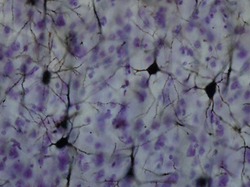Cerebralni korteks – razlika između verzija
Nova stranica: {{rut}}{{Infobox brain | Name = Cerebralni korteks | Latin = Cortex cerebri | GraySubject = | GrayPage = | Image = Brainmaps-macaque-hippo... |
(nema razlike)
|
Verzija na datum 1 juni 2014 u 14:22
Jedan korisnik upravo radi na ovom članku! Mole se ostali suradnici da ne uređuju članak dok je ova obavijest prisutna. Koristite stranicu za razgovor na ovom članku ako imate komentare i pitanja u vezi s člankom. Kada radovi budu gotovi, korisnik koji uređuje članak uklonit će ovaj šablon! Hvala na razumijevanju! Šablon može biti uklonjen ako kroz tri dana od trenutka postavljanja ili posljednje izmjene nema novih izmjena na članku. |
Cerebralni korteks je spoljašnji sloj strukture nervnog tkiva cerebruma (mozga), kod čoveka i drugih sisara. On pokriva cerebrum, i podeljen je u dva korteksa duž sagitalne ravni, koji pokrivaju levu i desnu cerabralnu hemisferu. medial longitudinal fissure is a deep groove that separates these two hemispheres. The cerebral cortex plays a key role in memory, attention, perceptual awareness, thought, language, and consciousness. The neocortex which is the major part of the cortex, consists of up to six horizontal layers, each with a different composition in terms of neurons and connectivity. The human cerebral cortex is 2 to 4 millimetres (0.079 to 0.157 in) thick.[1]
| Brain: Cerebralni korteks | ||
|---|---|---|

| ||
| Cerebralni korteks je spoljašnji slog prikazan tamno ljubičastom bojom. | ||

| ||
| Golgi-obojeni neuroni u korteksu. | ||
| Latinski | Cortex cerebri | |
| Deo | Telencefalon | |
| NeuroLex ID | birnlex_1494 | |
It is referred to as grey matter as it consists of cell bodies and capillaries and contrasts with the underlying white matter, that consists mainly of the white myelinated sheaths of neuronal axons.
In large mammals the surface of the cerebral cortex is folded, giving a much greater surface area in a confined space as in the skull. A fold or ridge in the cortex is termed a gyrus (plural gyri) and a groove or fissure is termed a sulcus (plural sulci). In the human brain more than two-thirds is buried in the sulci. The phylogenetically most recent part of the cerebral cortex, the neocortex (also called isocortex), is differentiated into six horizontal layers; the more ancient part of the cerebral cortex, the hippocampus, has at most three cellular layers. Neurons in various layers connect vertically to form small microcircuits, called cortical columns. Different neocortical regions known as Brodmann areas are distinguished by variations in their cytoarchitectonics (histological structure).
Reference
- ↑ Kandel, Eric R.; Schwartz, James H.; Jessell, Thomas M. (2000). Principles of Neural Science Fourth Edition. United State of America: McGraw-Hill. str. 324. ISBN 0-8385-7701-6.
Vanjske veze
- NeuroNames hier-20
- Webvision - The primary visual cortex Comprehensive article about the structure and function of the primary visual cortex.
- Webvision - Basic cell types Image of the basic cell types of the monkey cerebral cortex.
- Development of the Cerebral Cortex Different topics on cortical development in the form of columns written by leading scientists.
- Cerebral Cortex - Cell Centered Database
- NIF Search - Cerebral Cortex via the Neuroscience Information Framework